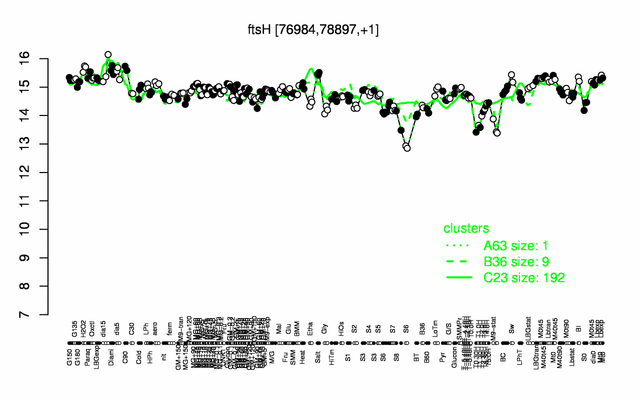FtsH
Revision as of 12:19, 16 May 2013 by 134.76.70.252 (talk)
- Description: ATP-dependent metalloprotease
| Gene name | ftsH |
| Synonyms | |
| Essential | no |
| Product | ATP-dependent metalloprotease |
| Function | cell division, sporulation initiation |
| Gene expression levels in SubtiExpress: ftsH | |
| Interactions involving this protein in SubtInteract: FtsH | |
| Metabolic function and regulation of this protein in SubtiPathways: Phosphorelay, Stress | |
| MW, pI | 70 kDa, 5.841 |
| Gene length, protein length | 1911 bp, 637 aa |
| Immediate neighbours | hprT, coaX |
| Sequences | Protein DNA DNA_with_flanks |
Genetic context 
This image was kindly provided by SubtiList
| |
Expression at a glance PubMed
| |
Contents
Categories containing this gene/protein
cell division, proteolysis, cell envelope stress proteins (controlled by SigM, V, W, X, Y), heat shock proteins, biofilm formation, membrane proteins
This gene is a member of the following regulons
The gene
Basic information
- Locus tag: BSU00690
Phenotypes of a mutant
Database entries
- DBTBS entry: [1]
- SubtiList entry: [2]
Additional information
The protein
Basic information/ Evolution
- Catalyzed reaction/ biological activity: degrades Spo0E and Spo0M, resulting in reduced sporulation frequency in a ftsH mutant PubMed
- Protein family:
- Paralogous protein(s): YjoB
Extended information on the protein
- Kinetic information:
- Domains:
- Modification:
- Cofactor(s):
- Effectors of protein activity:
Database entries
- UniProt: P37476
- KEGG entry: [3]
- E.C. number:
Additional information
Expression and regulation
- Regulation: induced by heat shock (class III)
- Regulatory mechanism:
- Additional information:
Biological materials
- Mutant:
- Expression vector:
- lacZ fusion:
- GFP fusion:
- two-hybrid system:
- Antibody:
Labs working on this gene/protein
Your additional remarks
References
Reviews
Additional reviews: PubMed
Original publications
Additional publications: PubMed